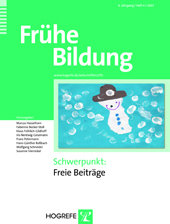Die Beobachtung von Interaktionen im Kindergartenalltag
Das Individualized Assessment Scoring System (inCLASS)
Abstract
Zusammenfassung. Interaktionen von Kindern mit Erwachsenen, mit Peers und mit der räumlich-materialen Umwelt spielen für Lernen und Entwicklung eine zentrale Rolle. Trotz der wachsenden Bedeutung der Entwicklungsdokumentation steht für den deutschen Kindergartenkontext bisher kein reliables Verfahren zur Beobachtung des Verhaltens von Kindern in Interaktionen zur Verfügung. Ziel der vorliegenden Studie war daher die Adaptation des in den USA entwickelten Individualized Classroom Assessment Scoring Systems (inCLASS). An der Studie nahmen 110 Kinder teil (57 Mädchen). Die in US-amerikanischen Stichproben gefundene faktorielle Struktur des inCLASS wurde weitgehend bestätigt. Interne Konsistenzen und Beobachterübereinstimmung waren zufriedenstellend. Die Ergebnisse weisen darauf hin, dass das inCLASS im deutschen Kindergartenkontext ein geeignetes Instrument zur Dokumentation des Verhaltens von Kindern in Interaktionen ist.
Abstract. Preschool learning experiences are mediated by children's interactions with adults, peers, and tasks. Although the documentation of children's development has gained importance, to date there is no reliable observational measure of children's interactions available for use in the German context. The aim of the present study was therefore the adaptation of the Individualized Classroom Assessment Scoring System (inCLASS), a measure developed in the US kindergarten context. Participants of the study were 110 children (57 girls). Results largely confirmed the factor structure of the inCLASS found in US samples. Internal consistencies as well as inter-rater reliability were satisfying. Findings suggest that the inCLASS is a suitable measure for documenting children's behavior in interactions in the German preschool context.
Literatur
(2002). Development of academic skills from preschool through second grade: Family and classroom predictors of developmental trajectories. Journal of School Psychology , 40 , 415 – 436.
(2000). Preschool peer interactions and readiness to learn: Relationships between classroom peer play and learning behaviors and conduct. Journal of Educational Psychology , 92 , 458 – 465.
(2006). Social-emotional competence as support for school readiness: What is it and how do we assess it. Early Education and Development , 17 , 57 – 89.
(2010). The Individualized Classroom Assessment Scoring System (inCLASS): Preliminary reliability and validity of a system for observing preschoolers' competence in classroom interactions. Early Childhood Research Quarterly , 25 , 1 – 16.
(2003). Young children's play quality in same-, other-, and mixed-sex peer groups. Child Development , 74 , 921 – 932.
(2005). An investigation of preschool classroom behavioral adjustment problems and social-emotional school readiness competencies. Early Childhood Research Quarterly , 20 , 259 – 275.
(2004). Preschool approaches to learning and their relationship to other relevant classroom competencies for low-income children. School Psychology Quarterly , 19 , 212 – 230.
(2001). Early teacher-child relationships and the trajectory of children's school outcomes through eighth grade. Child Development , 72 , 625 – 638.
(2006). Was wissen wir über guten Unterricht? Pädagogik , 2 , 42 – 45.
(2009). Observed classroom interaction processes between pre-school teachers and children: Results of a video study during free-play in German pre-schools. Educational and Child Psychology , 26 , 53 – 65.
(2008). Prozessqualität im Kindergarten – Konzept, Umsetzung und Befunde. Zeitschrift für Erziehungswissenschaft, Sonderheft 11 , 159 – 178.
(2006). Nonparental child care: Context, concepts, correlates and consequences. In W. Damon, R. M. Lerner, K. A. Renninger & I. E. Sigel (Eds.), Handbook of child psychology: Volume 4: Child psychology in practice ( 5th ed. , pp. 950 – 1016). Hoboken, NJ: Wiley.
(2009). Tackling social and cultural inequalities through early childhood education and care in Europe . Brussels, Belgium: The Education, Audiovisual and Culture Executive Agency (EACEA P9 Eurydice).
(2010). Bayesian analysis in Mplus: A brief introduction . Mplus Technical Report. Zugriff am 02.08.2013. Verfügbar unter http://www.statmodel.com
(2012). Bayesian structural equation modeling: A more flexible representation of substantive theory. Psychological Methods , 17 , 313 – 335.
(2010). A validation of the Classroom Assessment Scoring System in Finnish kindergartens. Early Education and Development , 21 , 95 – 124.
(2008). Classroom Assessment Scoring System – CLASS . Baltimore, MD: Brookes.
(1997). The nature of social competence: A theoretical review. Social Development , 6 , 111 – 135.
(1995). Complex sample data in structural equation modeling. Sociological methodology , 25 , 267 – 316.
(2013). Behavior regulation and early math and vocabulary knowledge in German preschool children. Early Education and Development , 24 , 310 – 331.
(2014). A gentle introduction to Bayesian analysis: Applications to developmental research. Child Development , 85 , 842 – 860.
(2012). Variation in children's engagement throughout the day in preschool: Relations to classroom and child factors. Early Childhood Research Quarterly , 27 , 210 – 220.
(2002). Beurteilerübereinstimmung und Beurteilerreliabilität . Göttingen: Hogrefe.



